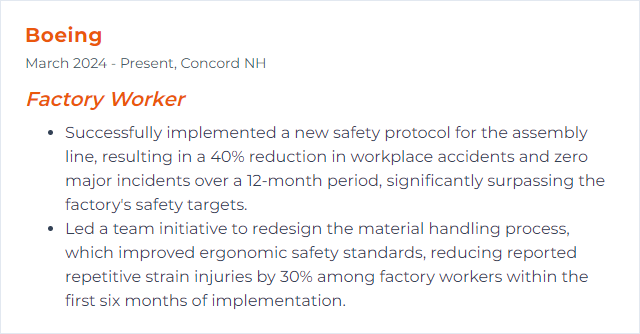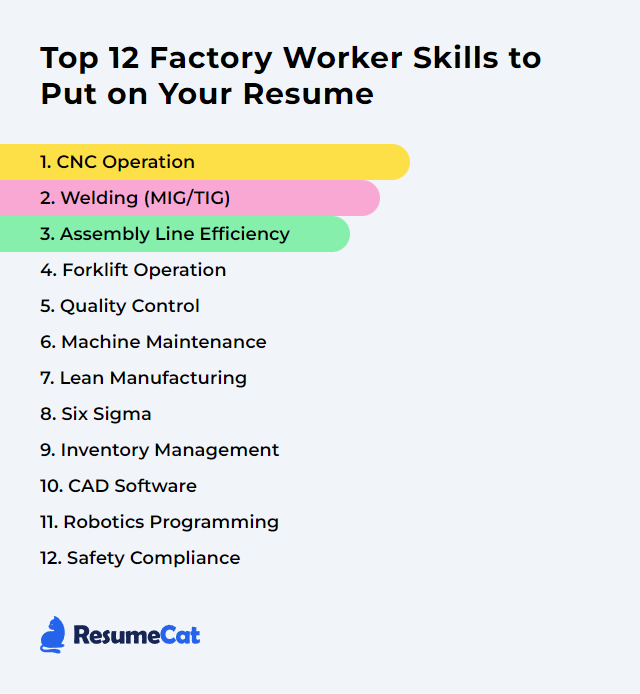Top 12 Factory Worker Skills to Put on Your Resume
In today's job market, factory workers who rise above the pile blend hands-on know-how with sharp problem-solving and communication. Put real skills on the page. Show proof of accuracy, safety, and speed. Employers notice when your resume reads like you’ve spent time on the floor, not just in a classroom.
Factory Worker Skills
- CNC Operation
- Welding (MIG/TIG)
- Assembly Line Efficiency
- Forklift Operation
- Quality Control
- Machine Maintenance
- Lean Manufacturing
- Six Sigma
- Inventory Management
- CAD Software
- Robotics Programming
- Safety Compliance
1. CNC Operation
CNC operation means running computer-controlled machines to cut, shape, and finish materials into precise parts using programmed instructions. Think repeatable accuracy, minimal guesswork, tight tolerances.
Why It's Important
CNC skills boost precision, speed up production, and reduce rework. Fewer errors. More consistency. Better throughput and quality, shift after shift.
How to Improve CNC Operation Skills
Focus on precision, repeatability, and safe throughput.
Keep learning: Deepen G-code knowledge, toolpaths, offsets, probing, and workholding. New tooling and strategies arrive fast—stay current.
Dial in cutting conditions: Match speed, feed, depth, and coolant to material and tool geometry. Track results; tweak deliberately.
Use quality tooling: Sharp, stable tools with correct coatings last longer and cut cleaner. Preset and balance where needed.
Simulate first: Verify programs offline. Catch collisions, gouges, and rapids before steel meets spindle.
In-process inspection: Measure critical dims during runs with gauges or probing. Adjust offsets before drift becomes scrap.
Lock in maintenance: Clean, lubricate, align. Check backlash and spindle health. A smooth machine holds tolerance.
Safety always: Proper guarding, chip control, PPE, and lockout/tagout when required.
How to Display CNC Operation Skills on Your Resume
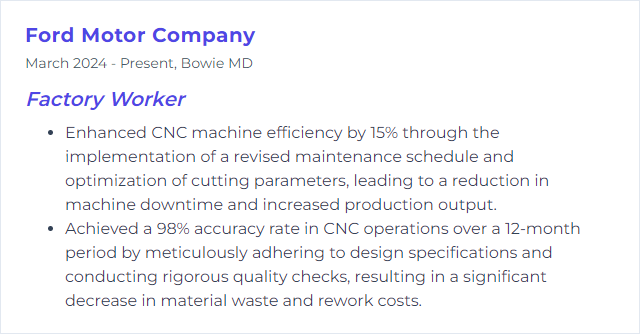
2. Welding (MIG/TIG)
MIG welding feeds a consumable wire with shielding gas for fast, strong joints. TIG welding uses a non-consumable tungsten electrode, often with filler, for precise, clean work where appearance and control matter.
Why It's Important
Solid welds hold products together—literally. Proper technique means durability, fewer defects, and safer assemblies.
How to Improve Welding (MIG/TIG) Skills
Steady hands, smart prep, and repeatable settings win.
Master fundamentals: Joint types, polarity, gas flow, wire and rod selection, and heat control.
Prep like a pro: Clean base metal. Good fit-up. Proper tacking to control distortion.
Refine technique: Practice torch angles, travel speed, stickout, and puddle control. Keep a weld log and photos to track improvements.
Know your materials: Adjust for steel, stainless, and aluminum—each has quirks.
Inspect your welds: Look for penetration, bead consistency, and defect-free finishes. Learn basic NDT methods used on the floor.
Safety first: Ventilation, PPE, fire watch, and cylinder handling. No shortcuts.
How to Display Welding (MIG/TIG) Skills on Your Resume
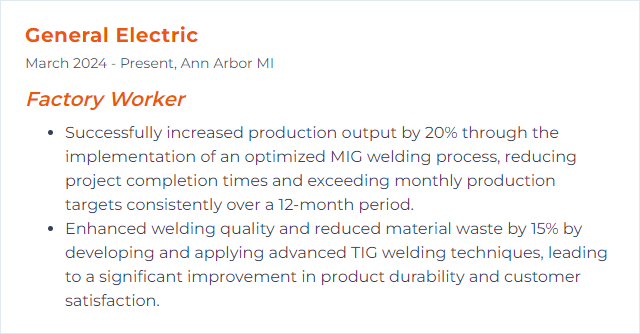
3. Assembly Line Efficiency
Assembly line efficiency is about smooth flow—doing the right task, the right way, at the right time, with minimal waiting, motion, or defects.
Why It's Important
Efficient lines hit targets without burnout. Less waste, less downtime, more predictable days—and better results.
How to Improve Assembly Line Efficiency Skills
Small fixes stack up fast.
Streamline workflow: Find bottlenecks. Balance stations. Shorten reach and walking time.
Standardize work: Clear steps, visual aids, and best-known methods. Variation drops; output rises.
Maintain equipment: Preventive checks reduce surprise stoppages. Quick-change tooling keeps pace.
Build skills: Cross-train to cover absences and flex with demand.
Quality at the source: In-station checks catch issues early. Rework shrinks; flow smooths.
Tight communication: Daily huddles, visible metrics, and fast feedback loops keep everyone aligned.
How to Display Assembly Line Efficiency Skills on Your Resume
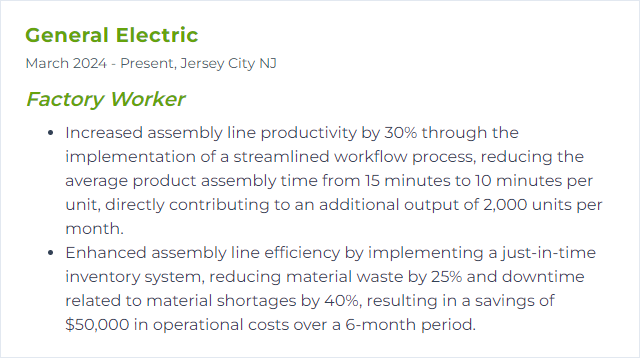
4. Forklift Operation
Forklift operation means safely driving powered industrial trucks to lift, move, and stack materials in tight aisles and busy bays.
Why It's Important
It moves the plant. Safe, efficient handling prevents injuries, protects product, and keeps production fed.
How to Improve Forklift Operation Skills
Precision plus awareness.
Get certified: Complete required training and evaluations per local regulations and company policy.
Inspect before use: Brakes, horn, forks, chains, fluids, tires. Report defects immediately.
Load discipline: Know capacities, keep loads low and stable, mind center of gravity, and stack square.
Situational awareness: Pedestrians, blind corners, floor conditions, and signage. Slow is smooth; smooth is fast.
Refine maneuvers: Three-point turns, tight placements, and gentle mast control save time and product.
How to Display Forklift Operation Skills on Your Resume

5. Quality Control
Quality Control ensures products meet standards before they leave the line—inspections, tests, and corrective action when things slip.
Why It's Important
It protects customers, reduces scrap, and keeps schedules intact. Trust is earned one good part at a time.
How to Improve Quality Control Skills
See more, earlier.
Know the spec: Drawings, tolerances, and critical-to-quality features. No guesswork.
Use the right tools: Calibrated gauges, torque tools, and check fixtures. Handle and store them properly.
Self-checks: Verify your own work at defined intervals. Catch drift fast.
Document issues: Clear defect descriptions, photos, lot traceability, and prompt escalation.
5S the area: Clean, organized stations reduce mix-ups and handling damage.
Close the loop: Share findings, help fix root causes, and confirm results stick.
How to Display Quality Control Skills on Your Resume

6. Machine Maintenance
Machine maintenance covers routine care, inspections, and repairs to keep equipment running safely and consistently.
Why It's Important
Healthy machines mean fewer breakdowns, safer shifts, and steady quality. Downtime is expensive; prevention is not.
How to Improve Machine Maintenance Skills
Be systematic.
Preventive schedule: Follow OEM intervals for lubrication, filters, belts, and alignments.
Condition monitoring: Watch vibration, temperature, and unusual noise. Act on early signals.
Clean machines run better: Chips, dust, and buildup shorten life. Daily wipe-downs matter.
Use a CMMS: Log work orders, parts, and histories. Trends guide smarter decisions.
Spare strategy: Stock critical components. Label and track to avoid surprises.
Safety procedures: Lockout/tagout, proper supports, and test-after-service checks every time.
How to Display Machine Maintenance Skills on Your Resume
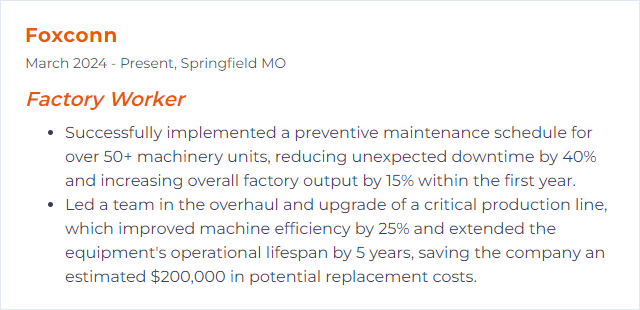
7. Lean Manufacturing
Lean Manufacturing removes waste and builds flow so teams make better products faster, with fewer headaches and less clutter.
Why It's Important
Waste drops, quality climbs, and work becomes simpler to do right. A safer, tidier workplace follows.
How to Improve Lean Manufacturing Skills
Continuous improvement is a habit.
Kaizen mindset: Notice small frictions and fix them. Every day.
Spot the seven wastes: Overproduction, waiting, transport, extra processing, inventory, motion, defects.
Standardized work: Best-known methods documented, trained, and audited.
Visual management: Clear labels, color cues, andon signals, and easy-to-read boards.
Participate in events: 5S, SMED, and value-stream mapping sessions turn ideas into action.
How to Display Lean Manufacturing Skills on Your Resume
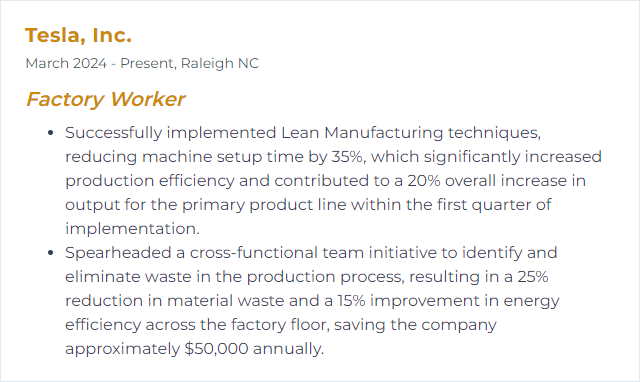
8. Six Sigma
Six Sigma is a data-driven approach to reduce variation and defects, usually through the DMAIC cycle: Define, Measure, Analyze, Improve, Control.
Why It's Important
Fewer defects mean smoother days, safer work, and happier customers. Better margins too.
How to Improve Six Sigma Skills
Think cause and effect.
Learn the basics: CTQs, sigma levels, process capability, and the DMAIC steps.
Use simple tools first: Pareto charts, check sheets, histograms, and control charts.
Root cause rigor: 5 Whys, fishbone diagrams, and clear problem statements.
Pilot improvements: Trial changes on a small scale, measure impact, then lock in.
Control the gains: Standardize, train, and monitor to prevent backsliding.
How to Display Six Sigma Skills on Your Resume
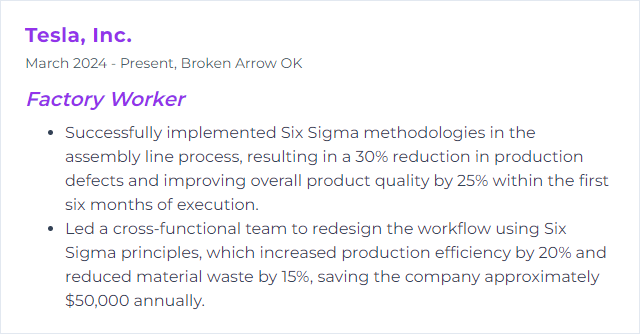
9. Inventory Management
Inventory management is tracking, storing, and replenishing materials so production never starves and cash isn’t trapped in excess stock.
Why It's Important
Right parts, right place, right time. Less downtime, fewer expedites, cleaner books.
How to Improve Inventory Management Skills
Clarity beats chaos.
Real-time tracking: Barcodes or RFID with disciplined scanning. No phantom stock.
Cycle counts: Little and often beats big and rare. Correct errors quickly.
ABC classification: Focus control on high-value or high-turn items.
Lean methods: Kanban, min-max, and pull signals to match demand.
Flow and layout: FIFO lanes, clear labels, and safe, fast pick paths.
Forecast and feedback: Blend history with current signals; communicate shifts early.
How to Display Inventory Management Skills on Your Resume
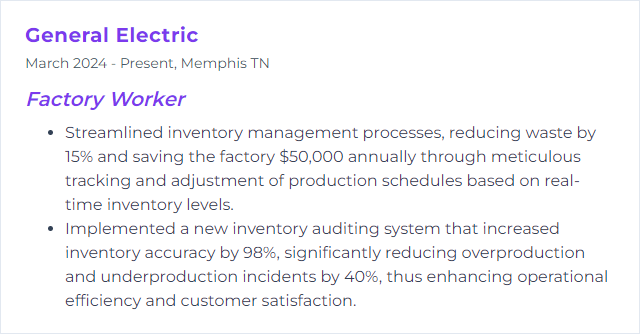
10. CAD Software
CAD software creates and edits precise models and drawings, turning ideas into manufacturable parts and clear instructions.
Why It's Important
It shortens the path from concept to production, clarifies communication, and reduces mistakes before they’re costly.
How to Improve CAD Software Skills
Build design intent, not just shapes.
Parametric modeling: Use constraints, features, and references so changes ripple correctly.
Drafting standards: Clean drawings with correct dimensions, GD&T, and clear notes.
Assemblies and BOMs: Manage mates, interference checks, and structured bills of materials.
Manufacturing handoff: Export for CAM/CNC, specify tolerances and finishes, and include critical datums.
Templates and libraries: Standard parts, title blocks, and materials save time and prevent errors.
Shortcuts and review: Hotkeys, design reviews, and lightweight configurations keep you moving.
How to Display CAD Software Skills on Your Resume
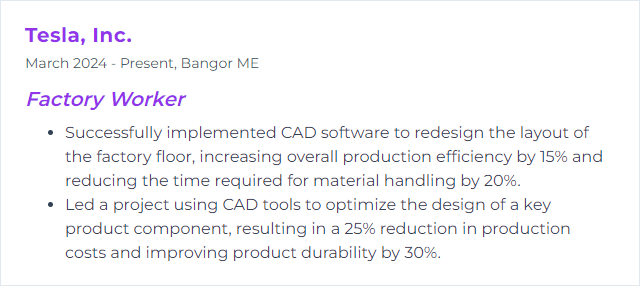
11. Robotics Programming
Robotics programming is writing and tuning code and teach pendant routines so robots assemble, pick, place, weld, or inspect without fuss.
Why It's Important
It boosts precision and throughput while pulling people away from repetitive or hazardous tasks.
How to Improve Robotics Programming Skills
Start grounded, then specialize.
Core concepts: Frames, kinematics, IO, safety zones, and program structure.
Languages and vendors: Get comfortable with Python/C++ and the specific controller languages you’ll see on site.
Offline simulation: Test paths, cycle times, and collision checks before touching the cell.
Integrate peripherals: Vision systems, grippers, welders, conveyors, and PLC handshakes.
Refine paths: Smooth motion, optimal approach angles, and robust recovery routines for real-world variation.
Document and back up: Version control, comments, and safe restore points save days.
How to Display Robotics Programming Skills on Your Resume
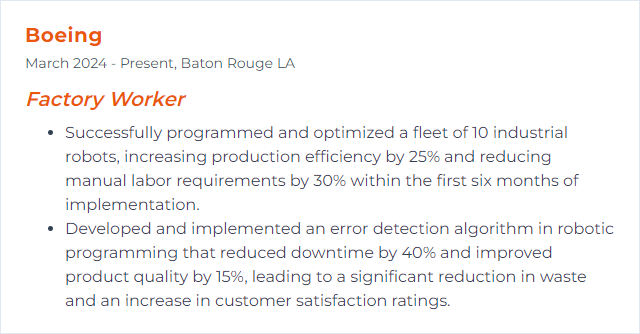
12. Safety Compliance
Safety compliance means following health and safety rules, procedures, and standards to control hazards and protect everyone on the floor.
Why It's Important
Safe work isn’t optional. It prevents injuries, avoids downtime, and builds a culture people trust.
How to Improve Safety Compliance Skills
Make it the way you work.
Know the rules: Understand your site procedures, emergency plans, and relevant standards (such as ISO 45001) used by your company.
PPE done right: Wear the correct gear and replace it when worn. Fit and condition matter.
Lockout/Tagout: Control hazardous energy before maintenance or jam clears. Verify zero energy state.
Housekeeping and ergonomics: Clear walkways, proper lift techniques, and smart workstation setup reduce injuries.
Near-miss reporting: Speak up early. Fix hazards before they become incidents.
Drills and refreshers: Practice evacuations, spill response, and first aid basics. Muscle memory counts.
How to Display Safety Compliance Skills on Your Resume
